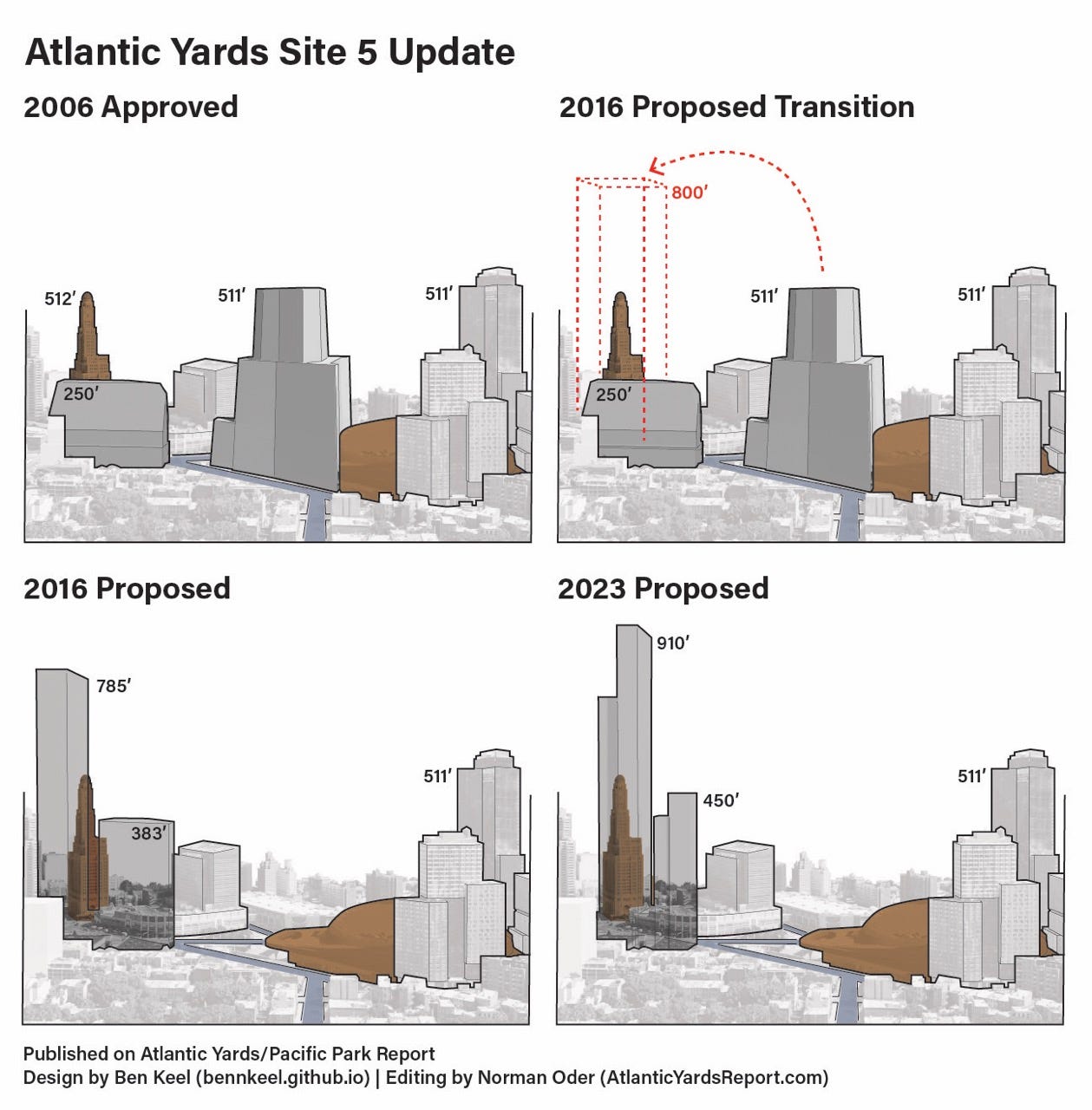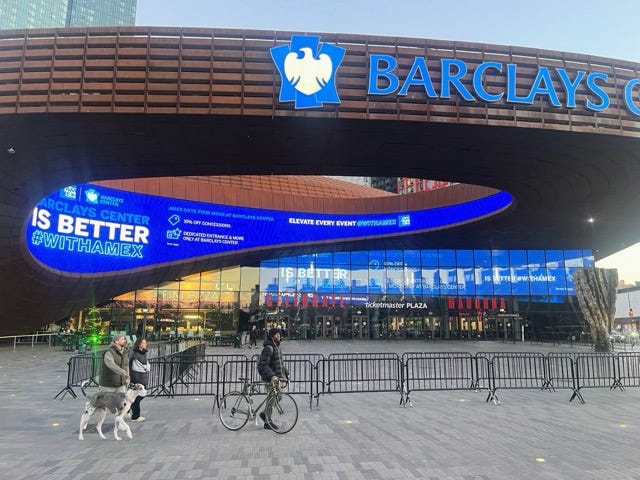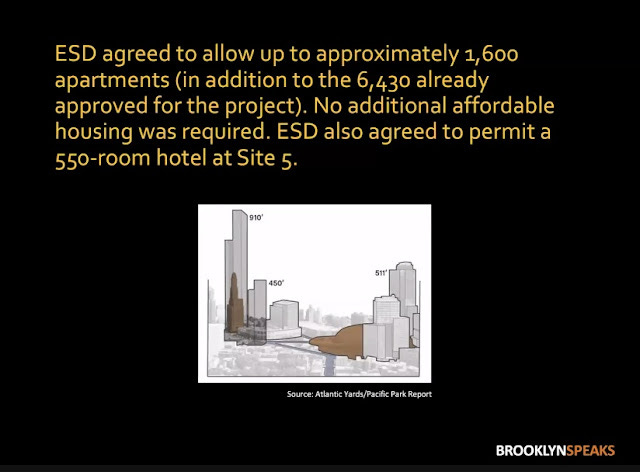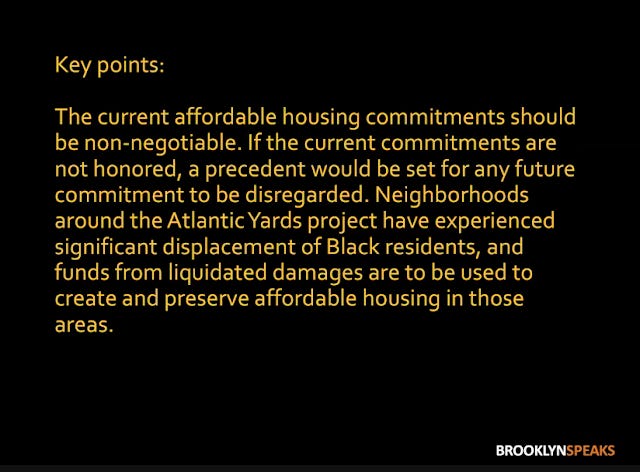BrooklynSpeaks to Elected Officials: Ensure Deeply Affordable Housing, Have Arena Operator Fund Monitors
Also: get financial analysis of proposed effort to supersize project. But will community coalition give carte blanche on scale?
What’s the “community response” to pending changing in Atlantic Yards/Pacific Park, involving six tower sites over the Metropolitan Transportation Authority’s Vanderbilt Yard and the parcel opposite the arena known as Site 5?
During a virtual meeting October 15 of the Prospect Heights Neighborhood Development Council (PHNDC), Chair Gib Veconi shared a presentation (see video and slides below) that the BrooklynSpeaks coalition--likely the key vector shaping local response--recently gave some elected officials and staff.
It's a timely and worthy effort, pushing back on some increased benefits that the developers, with state support, likely will pursue. However, it also deserves some caveats and shouldn’t be assumed to represent collective community sentiment.
The group’s takeaways:
don't let New York State give the developers a pass on fines for not delivering the 876 more required units of affordable housing by May 2025
given the project's skew toward more expensive "affordable housing," future income-targeted apartments should be aimed at low-income tenants
after failing to build the Urban Room atrium attached to the (unbuilt) flagship tower once slated to loom over the Barclays Center, the arena operators who control the "temporary" plaza should pay for a publicly operated quality of life enforcement unit
given the history of the project, which has kneecapped two developers, any proposed changes--including an expected request for increased density and bigger buildings--merit a third-party analysis of their financial feasibility
My take: there’s a potential tension between scale and affordability; the arena operators could be asked for even more; and third-party analyses are needed for more than financial feasibility.
What might happen
The unofficial images below were produced at my request by graphic designer Ben Keel. The sites with red and green indicate buildings constructed, with different configurations of affordable housing.
Above, the unofficial image of Proposed Plans, based on increased building heights, likely understates the change. Below, the evolution of plans for Site 5, long occupied by the big-box stores P.C. Richard and the now-closed Modell's.
Unmentioned: a tension over scale
Though Veconi's presentation provoked no discussion, I'd note that, while the need for more deeply affordable housing is crucial, but it comes with an inherent tension over scale.
That tension emerged when BrooklynSpeaks--a coalition of civic associations, community-based organizations, and advocacy groups aiming to improve and monitor Atlantic Yards-- held charrettes in 2022, known as Crossroads, prompted by plans for the Site 5 project.
At that time, BrooklynSpeaks similarly called for more affordable housing, but didn’t address the scale, spurring criticism from representative of the Pacific Bear’s Garden, which occupies a tiny triangle on the block that includes Site 5.
The developer's plan to shift bulk from the flagship tower to Site 5 would’ve meant nearly double the density of the Downtown Brooklyn rezoning. That plan, we’ve since learned, had been endorsed by the state in October 2021, with even more density.
It's likely that the developers--currently Greenland USA, with a joint venture involving Related Companies expected to enter--also will seek increased density for the six tower sites over the Vanderbilt Yard, as Greenland did last year, as shown in the image below.
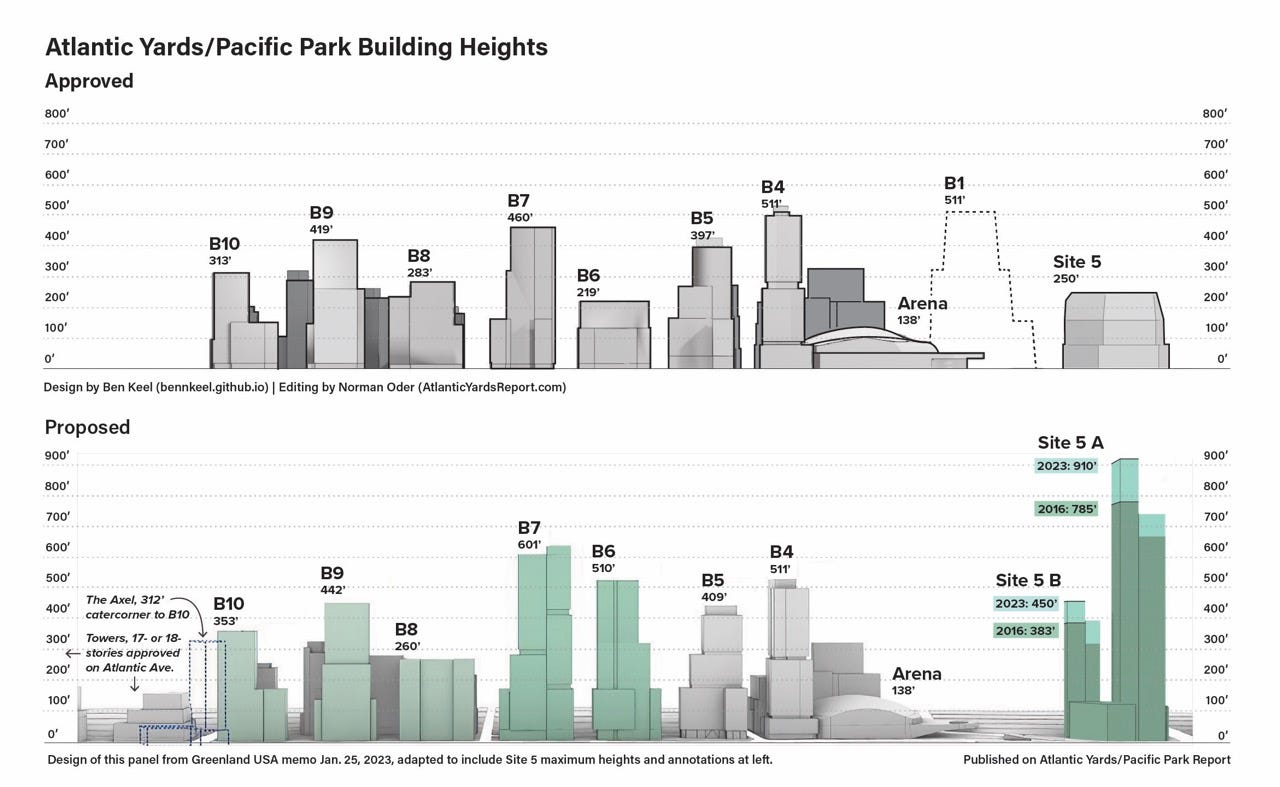
Also, Greenland already sought, and got state support for, an increase in density at Site 5. (That approval still requires approval by Empire State Development, the state authority that oversees/shepherds the project and which is controlled by the governor.)
The justification likely will be that only increased density can make the project more financially viable and thus deliver the affordable housing. (That, of course, was an initial justification for the project.)
At what point does the project overwhelm its neighbors? That question has been raised by veteran community planner Ron Shiffman, a member of the advisory Atlantic Yards Community Development Corporation (AY CDC).
Keep in mind that the nonprofit Fifth Avenue Committee, headed by key BrooklynSpeaks leader Michelle de la Uz, partnered with the developers on the nearby 80 Flatbush project, now known as the Alloy Block, arguing that their request for density, well beyond the Downtown Brooklyn rezoning, was justified by affordable housing promises. That tradeoff could recur.
Unmentioned: a broader analysis
Yes, it's worthwhile to get a third-party analysis of the project's financial viability—and also, I’d suggest, potential profits. (After all, beyond the increased bulk, the exterior LED signage at Site 5 is valuable, as is the below-grade retail.)
BrooklynSpeaks didn't mention a third-party analysis of other issues. In 2018, Jaime Stein, then a board member of the AY CDC, proposed that third-party planning, design and construction consultants review the pending Site 5 proposal to inform the board and the public.
That could get at the tension between fiscal feasibility and neighborhood impacts. However, her proposal got a cool reception from Empire State Development (ESD), which has its own consultant, AKRF, known for producing documents that justify any project changes.
About the plaza
Regarding the Urban Room, BrooklynSpeaks has a reasonable legal argument, given New York State's willingness to ignore project requirements. However, no one's pining for that atrium.
The broader argument, as I've articulated, is the enormous value the arena operator has reaped from the state-assisted arena and plaza, and the reciprocal need to give something back to the public.
Having the newly enriched arena operator (and Brooklyn Nets/New York Liberty owner) Joe Tsai fund a quality of life enforcement unit's a good start and represents clear reciprocity. But why not ask for more?
Why BrooklynSpeaks matters
BrooklynSpeaks started as what I called a "mend it, don't end it" alternative to project opponents Develop Don't Destroy Brooklyn.
Given that the latter is defunct, and many once active in Atlantic Yards are fatigued, that leaves BrooklynSpeaks as the default organization to comment on the project. Notably, it organized a potential lawsuit in 2014 that led to a settlement, including the new 2025 deadline for affordable housing.
That timeline was a significant achievement, but the settlement, which BrooklynSpeaks’ de la Uz said meant "the community finally gets the affordable housing it was promised 10 years ago," did not, in fact, prevent the skew toward middle-income affordable housing.
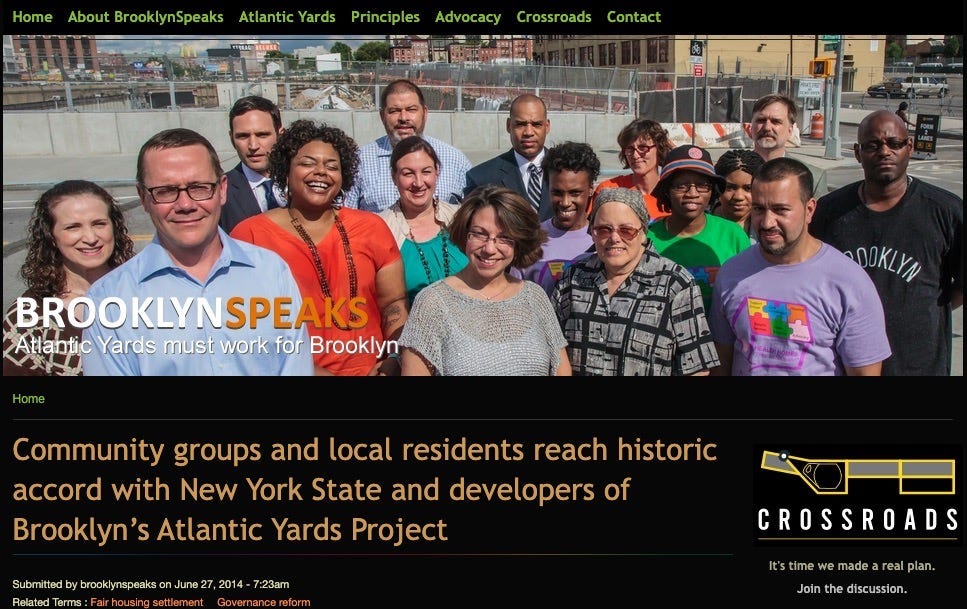
The advisory body created, the AY CDC, has been mostly toothless, meeting infrequently and with little notice to the public, though recently a few Directors, notably Veconi and veteran community planner Ron Shiffman, have challenged state officials.
That makes the few people active in BrooklynSpeaks--as far as I can tell, Veconi and de la Uz, with Assemblymember Jo Anne Simon close to them--key voices in the public discourse.
Consider the BrooklynSpeaks statement when news of the foreclosure surfaced, the op-ed that Veconi and de la Uz published in the New York Daily News (my critique), or the article in the nonprofit news site The CITY, which quoted Veconi, Simon, and also Shiffman.
Do the member organizations in BrooklynSpeaks actively set policy that leaders like Veconi and de la Uz articulate? Given that those issues are not publicly discussed, I highly doubt it.
The video (go to 47:12)
From the video presentation
Veconi described how developer Greenland USA, the American arm of a Shanghai-based firm, failed to pay back most of $349 million in loans from immigrant investors under the EB-5 investor visa program and now faces foreclosure, with the collateral being development rights for six towers over the Vanderbilt Yard, east of the arena.
The process is controlled by the U.S. Immigration Fund, a "regional center" middleman that organized the EB-5 investors, and the Fortress Investment Group, a private equity fund that acquired some of the debt.
While Greenland USA retains control of Site 5, Veconi said, they likely will try to market the development rights there.
That may be tricky, given that a public approval process is needed to increase density at Site 5. However, the state and the developer--whoever it is--are allied.
New bonus for Site 5
Veconi noted that, in October 2021, Empire State Development quietly negotiated a Site 5 development lease with Greenland, "without a formal modification of the project plan or the required environmental review."
That, as I reported, removed the B1 flagship tower from the project, made the plaza permanent, and allowed an even larger project, while transferring the bulk from B1 across the street.
(Note: the phrase "We recently discovered" alludes to the fact that both Veconi and I filed Freedom of Information Law requests to unearth the document. Only I published it, however.)
Site 5 was approved at 250 feet, with plans floated in 2016 for a two-tower project rising as high as 785 feet, given a transfer of bulk from B1.
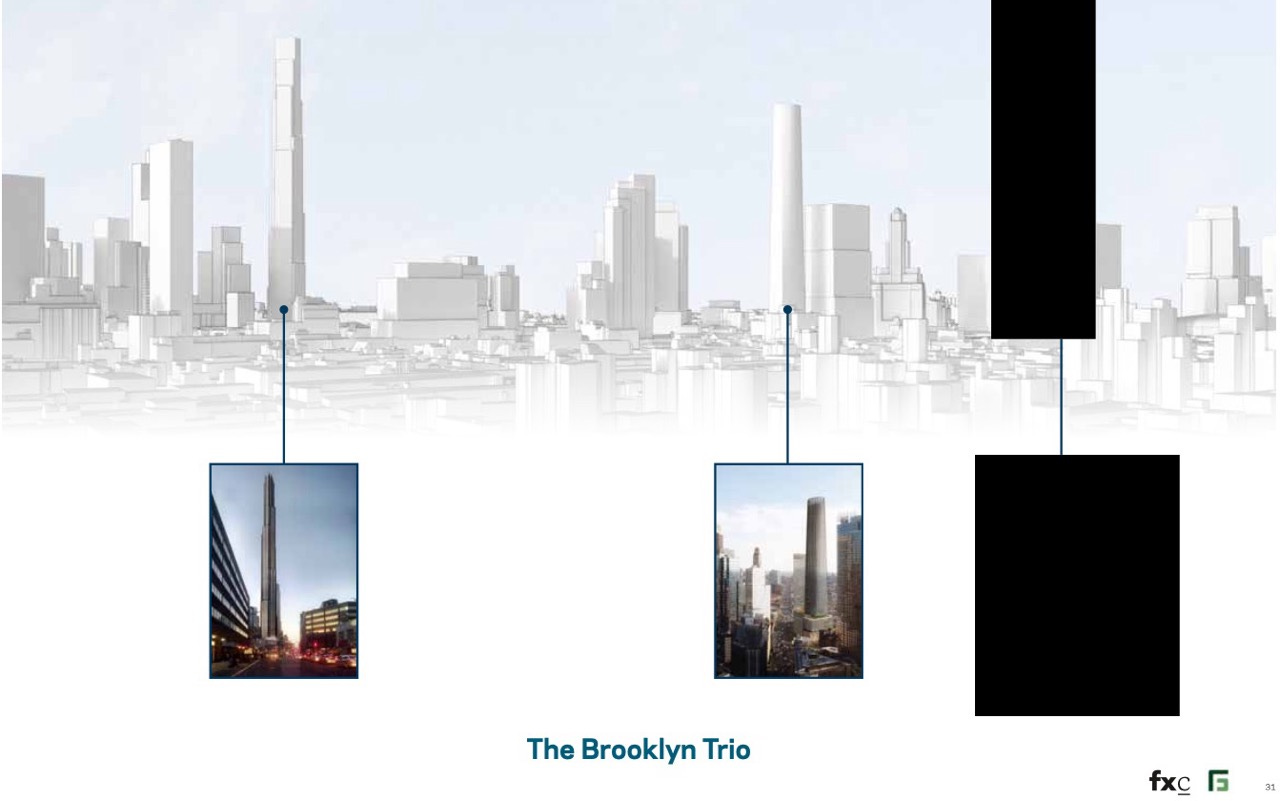
The latest document allows a building 910 feet, or perhaps 80-90 stories, the second-tallest building in Brooklyn after The Brooklyn Tower, and larger than the taller tower in the Alloy Block. They’d form what a 2018 developer’s presentation—albeit with the Site 5 tower redacted—called “The Brooklyn Trio.”
Moreover, Exhibit K of the Site 5 Interim Lease offers bonuses beyond bulk: the opportunity to add valuable LED signage to the building, and the swap of required below-grade parking for valuable retail space.
(Note that, when the developer of 595 Dean Street, including the B12/B13 towers, proposed the swap of parking for a below-grade Chelsea Piers fitness center and field house, BrooklynSpeaks rightly protested that such a giveaway demanded reciprocity for the public. Empire State Development approved it anyway.)
More apartments
Site 5 would contain perhaps 1,600 apartments, as well as a large 550-room hotel. Veconi noted that no additional affordable housing was required.
ESD officials have indicated any such project would include a measure of affordable housing.
Indeed, as I reported, the developer’s 2023 proposal included 600 more below-market apartments across Site 5 and the railyard sites, albeit without specifying the level of affordability.
Removing the Urban Room
ESD, noted Veconi, also agreed to remove the Urban Room, making the plaza outside Barclays Center--now on its fourth sponsor (Ticketmaster), I'd note--permanent.
The atrium at the base of B1, he said, was "a key public benefit," with "a hard deadline and monetary damages" of $10 million.
While in July 2022, elected officials organized by BrooklynSpeaks called on ESD to collect the damages, the state authority had already agreed to remove it from the project, without disclosing that, he said.
As I wrote at the time, it was hard to argue that public officials and community groups were truly pining for the atrium, which, while offering an enclosed space, did not provide as much open space as the plaza.
(That’s because, among other things, the plaza doesn’t have to share atrium space with an office building.)
The protest, rather, was a test run to see if ESD would be accountable for the looming 2025 affordable housing deadline. The state authority's recalcitrance on the Urban Room suggested it would follow the developer's interest on other fronts.
(The elected officials involved were Assemblymembers Jo Anne Simon, Phara Souffrant Forrest, and Robert Carroll; State Senator Jabari Brisport; and City Council Member Crystal Hudson. Borough President Antonio Reynoso also attended the press conference. So these officials are likely among the group recently briefed by BrooklynSpeaks.)
Bigger buildings
Along with the Site 5 changes already agreed on, "Greenland in 2023 proposed additional changes to the Atlantic Yards project that would result in larger buildings along Atlantic Avenue," Veconi said, referencing in the sites over the rail yard that haven't been developed.
As I wrote, the actual square footage proposed by Greenland likely exceeds the dimensions of the buildings shown in the graphic, which was revised by Keel.
Veconi noted that Greenland's rationale was that it needed bigger building to make the project financially viable, including the cost of the platform over the railyard. The expected joint venture involving Related likely also will seek increased density and an extension of the affordable housing deadline.
Unmentioned: as I wrote, Greenland, while proposing an extended deadline, also proposed more affordable housing, albeit without specifying the level of affordability.
The deadline
Veconi argued against extending that deadline and waiving the fines of $2,000/month for each unbuilt unit, which would go to the New York City Housing Trust Fund to build or preserve affordable housing in the four community districts that were to receive preference for the project's affordable housing--and which have seen a significant drop in the Black population.
"We don't believe that these developers should be given any any latitude on the liquidated damages, because the affordable housing that it was the project was supposed to be provided is so desperately needed," he said. (He didn't mention the likelihood that the carrot for the extension would be more affordable units.)
Reversing the skew
The affordable housing now has been skewed to middle-income households, many earning six figures, contra the project's original promises.
"We also believe that future affordable housing in Atlantic Yards has to reach low income tenants," Veconi said, advocating for a consistent 35% level of affordability in the project, with an average of 60% Area Median Income (AMI), with 10% of the total units at 40% AMI, it must be permanently affordable.
The trade-off, and tension, may be density.
Benefit from the Urban Room
In exchange for removing the Urban Room, the public should be compensated, he said, "through a charge to the arena operators that could be used to pay for the cost of a publicly operated quality of life enforcement unit, which, if you've spent any time at the intersection of Flatbush Avenue and Atlantic Avenue, you know, is desperately necessary."
As I noted, that's a good start, but I think they could ask for more.
Project viability
"We believe that the public and its elected representatives have to have a good reason to believe a new plan can be completed," said Veconi. "We need a third-party analysis of the financial feasibility of these proposed changes, and the elected officials need to be given due time to evaluate those findings."
Again, that's a reasonable request, but limiting the analysis to financial feasibility does too little to represent the public interest.
Rather, how realistic is the density sought? What are alternative views of the proposed buildings? What are alternative assessments of proposed impacts? New York State relies on a consultant, AKRF, which has a reputation for delivering for its clients, not necessarily the public.






